A Preliminary Study of the Potential Molecular Mechanisms of Individual Growth and Rumen Development in Calves with Different Feeding Patterns
Abstract
1. Introduction
2. Materials and Methods
2.1. Ethics Statement
2.2. Animals
2.3. Sample Collection
2.4. DNA Extraction, Metagenomic Sequencing
2.5. Classification and Functional Annotation of Rumen Metagenomes
2.6. Rumen Fluid SCFA and Serum Metabolomic Analysis
2.7. Statistical Analysis
3. Results
3.1. Growth Traits Characteristics of Calves
3.2. Analysis of the Rumen Metagenome
3.3. Compositional Characteristics and Taxonomic Differences of the Microbiome
3.4. Functional Characteristics and Functional Differences of Microbiome
3.5. The Relationship between the Types of Rumen Microorganisms and Their Functions
3.6. Analysis of Serum Metabolomics
3.7. Correlation Analysis of the Metabolites and Microorganisms
4. Discussion
5. Conclusions
Supplementary Materials
Author Contributions
Funding
Institutional Review Board Statement
Informed Consent Statement
Data Availability Statement
Acknowledgments
Conflicts of Interest
References
- Monteverde, V.; Congiu, F.; Vazzana, I.; Dara, S.; Di Pietro, S.; Piccione, G. Serum lipid profile modification related to polyunsaturated fatty acid supplementation in thoroughbred horses. J. Appl. Anim. Res. 2017, 45, 615–618. [Google Scholar] [CrossRef]
- Liu, F.; Hogg, J.; Kracht, S.; Brewster, C.J.; Henman, D.J.; Athorn, R.Z.; Morrison, R.S.; Smits, R.J.; Campbell, R.G. Supplementing 2 g per day bovine lactoferrin from late gestation until weaning did not improve lactation performance of mixed parity sows. Anim. Prod. Sci. 2019, 59, 615–618. [Google Scholar] [CrossRef]
- Lin, L.; Xie, F.; Sun, D.; Liu, J.; Zhu, W.; Mao, S. Ruminal microbiome-host crosstalk stimulates the development of the ruminal epithelium in a lamb model. Microbiome 2019, 7, 83. [Google Scholar] [CrossRef] [PubMed]
- Soberon, F.; Raffrenato, E.; Everett, R.W.; Van Amburgh, M.E. Preweaning milk replacer intake and effects on long-term productivity of dairy calves. J. Dairy Sci. 2012, 95, 783–793. [Google Scholar] [CrossRef]
- Zitnan, R.; Voigt, J.; Schönhusen, U.; Wegner, J.; Kokardová, M.; Hagemeister, H.; Levkut, M.; Kuhla, S.; Sommer, A. Influence of dietary concentrate to forage ratio on the development of rumen mucosa in calves. Arch. Tierernahr. 1998, 51, 279–291. [Google Scholar] [CrossRef]
- Overvest, M.A.; Bergeron, R.; Haley, D.B.; DeVries, T.J. Effect of feed type and method of presentation on feeding behavior, intake, and growth of dairy calves fed a high level of milk. J. Dairy Sci. 2016, 99, 317–327. [Google Scholar] [CrossRef]
- Baldwin, R.L.; McLeod, K.R.; Klotz, J.L.; Heitmann, R.N. Rumen Development, Intestinal Growth and Hepatic Metabolism in the Pre- and Postweaning Ruminant. J. Dairy Sci. 2004, 87, E55–E65. [Google Scholar] [CrossRef]
- Mojahedi, S.; Khorvash, M.; Ghorbani, G.R.; Ghasemi, E.; Mirzaei, M.; Hashemzadeh-Cigari, F. Performance, nutritional behavior, and metabolic responses of calves supplemented with forage depend on starch fermentability. J. Dairy Sci. 2018, 101, 7061–7072. [Google Scholar] [CrossRef]
- Hosseini, S.M.; Ghorbani, G.R.; Rezamand, P.; Khorvash, M. Determining optimum age of Holstein dairy calves when adding chopped alfalfa hay to meal starter diets based on measures of growth and performance. Animal 2016, 10, 607–615. [Google Scholar] [CrossRef]
- Jami, E.; White, B.A.; Mizrahi, I. Potential role of the bovine rumen microbiome in modulating milk composition and feed efficiency. PLoS ONE 2014, 9, e85423. [Google Scholar] [CrossRef]
- Wallace, R.J.; Sasson, G.; Garnsworthy, P.C.; Tapio, I.; Gregson, E.; Bani, P.; Huhtanen, P.; Bayat, A.R.; Strozzi, F.; Biscarini, F.; et al. A heritable subset of the core rumen microbiome dictates dairy cow productivity and emissions. Sci. Adv. 2019, 5, eaav8391. [Google Scholar] [CrossRef] [PubMed]
- Ye, Z.; Xu, Y.-J.; Liu, Y. Influences of dietary oils and fats, and the accompanied minor content of components on the gut microbiota and gut inflammation: A review. Trends Food Sci. Technol. 2021, 113, 255–276. [Google Scholar] [CrossRef]
- Lazuka, A.; Auer, L.; O’Donohue, M.; Hernandez-Raquet, G. Anaerobic lignocellulolytic microbial consortium derived from termite gut: Enrichment, lignocellulose degradation and community dynamics. Biotechnol. Biofuels 2018, 11, 284. [Google Scholar] [CrossRef]
- Fernando, S.C.; Purvis, H.T., 2nd; Najar, F.Z.; Sukharnikov, L.O.; Krehbiel, C.R.; Nagaraja, T.G.; Roe, B.A.; Desilva, U. Rumen microbial population dynamics during adaptation to a high-grain diet. Appl. Environ. Microbiol. 2010, 76, 7482–7490. [Google Scholar] [CrossRef]
- Xie, F.; Anderson, C.L.; Timme, K.R.; Kurz, S.G.; Fernando, S.C.; Wood, J.R. Obesity-Dependent Increases in Oocyte mRNAs Are Associated With Increases in Proinflammatory Signaling and Gut Microbial Abundance of Lachnospiraceae in Female Mice. Endocrinology 2016, 157, 1630–1643. [Google Scholar] [CrossRef] [PubMed]
- Poudel, P.; Froehlich, K.; Casper, D.P.; St-Pierre, B. Feeding Essential Oils to Neonatal Holstein Dairy Calves Results in Increased Ruminal Prevotellaceae Abundance and Propionate Concentrations. Microorganisms 2019, 7, 120. [Google Scholar] [CrossRef] [PubMed]
- Leal, L.N.; Doelman, J.; Keppler, B.R.; Steele, M.A.; Martín-Tereso, J. Preweaning nutrient supply alters serum metabolomics profiles related to protein and energy metabolism and hepatic function in Holstein heifer calves. J. Dairy Sci. 2021, 104, 7711–7724. [Google Scholar] [CrossRef]
- Qi, Y.; Zhao, X.; Huang, D.; Pan, X.; Yang, Y.; Zhao, H.; Hu, H.; Cheng, G. Exploration of the Relationship between Intestinal Colostrum or Milk, and Serum Metabolites in Neonatal Calves by Metabolomics Analysis. J. Agric. Food Chem. 2018, 66, 7200–7208. [Google Scholar] [CrossRef]
- Terler, G.; Poier, G.; Klevenhusen, F.; Zebeli, Q. Replacing concentrates with a high-quality hay in the starter feed in dairy calves: I. Effects on nutrient intake, growth performance, and blood metabolic profile. J. Dairy Sci. 2022, 105, 2326–2342. [Google Scholar] [CrossRef]
- Taylor, E.N.; Han, J.; Fan, C.; Beckmann, M.; Hewinson, G.; Rooke, D.; Koets, A.P.; Mur, L.A.J. Defining Fatty Acid Changes Linked to Rumen Development, Weaning and Growth in Holstein-Friesian Heifers. Metabolites 2022, 12, 374. [Google Scholar] [CrossRef]
- Karlsson, F.H.; Fåk, F.; Nookaew, I.; Tremaroli, V.; Fagerberg, B.; Petranovic, D.; Bäckhed, F.; Nielsen, J. Symptomatic atherosclerosis is associated with an altered gut metagenome. Nat. Commun. 2012, 3, 1245. [Google Scholar] [CrossRef]
- Fosso, B.; Santamaria, M.; D’Antonio, M.; Lovero, D.; Corrado, G.; Vizza, E.; Passaro, N.; Garbuglia, A.R.; Capobianchi, M.R.; Crescenzi, M.; et al. MetaShot: An accurate workflow for taxon classification of host-associated microbiome from shotgun metagenomic data. Bioinformatics 2017, 33, 1730–1732. [Google Scholar] [CrossRef] [PubMed]
- Nielsen, H.B.; Almeida, M.; Juncker, A.S.; Rasmussen, S.; Li, J.; Sunagawa, S.; Plichta, D.R.; Gautier, L.; Pedersen, A.G.; Le Chatelier, E.; et al. Identification and assembly of genomes and genetic elements in complex metagenomic samples without using reference genomes. Nat. Biotechnol. 2014, 32, 822–828. [Google Scholar] [CrossRef] [PubMed]
- Karlsson, F.H.; Tremaroli, V.; Nookaew, I.; Bergström, G.; Behre, C.J.; Fagerberg, B.; Nielsen, J.; Bäckhed, F. Gut metagenome in European women with normal, impaired and diabetic glucose control. Nature 2013, 498, 99–103. [Google Scholar] [CrossRef]
- Zeller, G.; Tap, J.; Voigt, A.Y.; Sunagawa, S.; Kultima, J.R.; Costea, P.I.; Amiot, A.; Böhm, J.; Brunetti, F.; Habermann, N.; et al. Potential of fecal microbiota for early-stage detection of colorectal cancer. Mol. Syst. Biol. 2014, 10, 766. [Google Scholar] [CrossRef] [PubMed]
- Sunagawa, S.; Coelho, L.P.; Chaffron, S.; Kultima, J.R.; Labadie, K.; Salazar, G.; Djahanschiri, B.; Zeller, G.; Mende, D.R.; Alberti, A.; et al. Ocean plankton. Structure and function of the global ocean microbiome. Science 2015, 348, 1261359. [Google Scholar] [CrossRef]
- Fu, L.; Niu, B.; Zhu, Z.; Wu, S.; Li, W. CD-HIT: Accelerated for clustering the next-generation sequencing data. Bioinformatics 2012, 28, 3150–3152. [Google Scholar] [CrossRef]
- Qin, J.; Li, Y.; Cai, Z.; Li, S.; Zhu, J.; Zhang, F.; Liang, S.; Zhang, W.; Guan, Y.; Shen, D.; et al. A metagenome-wide association study of gut microbiota in type 2 diabetes. Nature 2012, 490, 55–60. [Google Scholar] [CrossRef]
- Oh, J.; Byrd, A.L.; Deming, C.; Conlan, S.; Kong, H.H.; Segre, J.A. Biogeography and individuality shape function in the human skin metagenome. Nature 2014, 514, 59–64. [Google Scholar] [CrossRef]
- Feng, Q.; Liang, S.; Jia, H.; Stadlmayr, A.; Tang, L.; Lan, Z.; Zhang, D.; Xia, H.; Xu, X.; Jie, Z.; et al. Gut microbiome development along the colorectal adenoma-carcinoma sequence. Nat. Commun. 2015, 6, 6528. [Google Scholar] [CrossRef]
- Villar, E.; Farrant, G.K.; Follows, M.; Garczarek, L.; Speich, S.; Audic, S.; Bittner, L.; Blanke, B.; Brum, J.R.; Brunet, C.; et al. Ocean plankton. Environmental characteristics of Agulhas rings affect interocean plankton transport. Science 2015, 348, 1261447. [Google Scholar] [CrossRef] [PubMed]
- Buchfink, B.; Xie, C.; Huson, D.H. Fast and sensitive protein alignment using DIAMOND. Nat. Methods 2015, 12, 59–60. [Google Scholar] [CrossRef] [PubMed]
- Avershina, E.; Frisli, T.; Rudi, K. De novo semi-alignment of 16S rRNA gene sequences for deep phylogenetic characterization of next generation sequencing data. Microbes Environ. 2013, 28, 211–216. [Google Scholar] [CrossRef]
- Segata, N.; Izard, J.; Waldron, L.; Gevers, D.; Miropolsky, L.; Garrett, W.S.; Huttenhower, C. Metagenomic biomarker discovery and explanation. Genome Biol. 2011, 12, R60. [Google Scholar] [CrossRef] [PubMed]
- Kanehisa, M.; Goto, S.; Sato, Y.; Kawashima, M.; Furumichi, M.; Tanabe, M. Data, information, knowledge and principle: Back to metabolism in KEGG. Nucleic Acids Res. 2014, 42, D199–D205. [Google Scholar] [CrossRef]
- Scher, J.U.; Sczesnak, A.; Longman, R.S.; Segata, N.; Ubeda, C.; Bielski, C.; Rostron, T.; Cerundolo, V.; Pamer, E.G.; Abramson, S.B.; et al. Expansion of intestinal Prevotella copri correlates with enhanced susceptibility to arthritis. eLife 2013, 2, e01202. [Google Scholar] [CrossRef]
- Wen, B.; Mei, Z.; Zeng, C.; Liu, S. metaX: A flexible and comprehensive software for processing metabolomics data. BMC Bioinform. 2017, 18, 183. [Google Scholar] [CrossRef]
- Liu, S.J.; Bu, D.P.; Wang, J.Q.; Liu, L.; Liang, S.; Wei, H.Y.; Zhou, L.Y.; Li, D.; Loor, J.J. Effect of incremental levels of fish oil supplementation on specific bacterial populations in bovine ruminal fluid. J. Anim. Physiol. Anim. Nutr. 2012, 96, 9–16. [Google Scholar] [CrossRef]
- Wales, W.J.; Kolver, E.S.; Thorne, P.L.; Egan, A.R. Diurnal variation in ruminal pH on the digestibility of highly digestible perennial ryegrass during continuous culture fermentation. J. Dairy Sci. 2004, 87, 1864–1871. [Google Scholar] [CrossRef]
- DePeters, E.J.; Bath, D.L. Canola Meal Versus Cottonseed Meal as the Protein Supplement in Dairy Diets. J. Dairy Sci. 1986, 69, 148–154. [Google Scholar] [CrossRef]
- Krehbiel, C.R.; Harmon, D.L.; Schneider, J.E. Effect of increasing ruminal butyrate on portal and hepatic nutrient flux in steers. J. Anim. Sci. 1992, 70, 904–914. [Google Scholar] [CrossRef] [PubMed]
- McLeod, K.R.; Baldwin, R.L.T. Effects of diet forage:concentrate ratio and metabolizable energy intake on visceral organ growth and in vitro oxidative capacity of gut tissues in sheep. J. Anim. Sci. 2000, 78, 760–770. [Google Scholar] [CrossRef] [PubMed]
- Ma, J.; Wang, C.; Wang, Z.; Cao, G.; Hu, R.; Wang, X.; Zou, H.; Kang, K.; Peng, Q.; Xue, B.; et al. Active dry yeast supplementation improves the growth performance, rumen fermentation, and immune response of weaned beef calves. Anim. Nutr. 2021, 7, 1352–1359. [Google Scholar] [CrossRef] [PubMed]
- Spears, J.W.; Schlegel, P.; Seal, M.C.; Lloyd, K.E. Bioavailability of zinc from zinc sulfate and different organic zinc sources and their effects on ruminal volatile fatty acid proportions. Livest. Prod. Sci. 2004, 90, 211–217. [Google Scholar] [CrossRef]
- Matthews, C.; Crispie, F.; Lewis, E.; Reid, M.; O’Toole, P.W.; Cotter, P.D. The rumen microbiome: A crucial consideration when optimising milk and meat production and nitrogen utilisation efficiency. Gut Microbes 2019, 10, 115–132. [Google Scholar] [CrossRef]
- Kang, J.; Zeng, B.; Tang, S.; Wang, M.; Han, X.; Zhou, C.; Yan, Q.; Liu, J.; Tan, Z. Effects of Momordica charantia polysaccharide on in vitro ruminal fermentation and cellulolytic bacteria. Ital. J. Anim. Sci. 2017, 16, 226–233. [Google Scholar] [CrossRef]
- Shabat, S.K.; Sasson, G.; Doron-Faigenboim, A.; Durman, T.; Yaacoby, S.; Berg Miller, M.E.; White, B.A.; Shterzer, N.; Mizrahi, I. Specific microbiome-dependent mechanisms underlie the energy harvest efficiency of ruminants. ISME J. 2016, 10, 2958–2972. [Google Scholar] [CrossRef]
- Jami, E.; Israel, A.; Kotser, A.; Mizrahi, I. Exploring the bovine rumen bacterial community from birth to adulthood. ISME J. 2013, 7, 1069–1079. [Google Scholar] [CrossRef]
- Kovatcheva-Datchary, P.; Nilsson, A.; Akrami, R.; Lee, Y.S.; De Vadder, F.; Arora, T.; Hallen, A.; Martens, E.; Björck, I.; Bäckhed, F. Dietary Fiber-Induced Improvement in Glucose Metabolism Is Associated with Increased Abundance of Prevotella. Cell Metab. 2015, 22, 971–982. [Google Scholar] [CrossRef]
- Sakamoto, M.; Umeda, M.; Ishikawa, I.; Benno, Y. Prevotella multisaccharivorax sp. nov., isolated from human subgingival plaque. Int. J. Syst. Evol. Microbiol. 2005, 55, 1839–1843. [Google Scholar] [CrossRef]
- Stevenson, D.M.; Weimer, P.J. Dominance of Prevotella and low abundance of classical ruminal bacterial species in the bovine rumen revealed by relative quantification real-time PCR. Appl. Microbiol. Biotechnol. 2007, 75, 165–174. [Google Scholar] [CrossRef] [PubMed]
- Balch, W.E.; Fox, G.E.; Magrum, L.J.; Woese, C.R.; Wolfe, R.S. Methanogens: Reevaluation of a unique biological group. Microbiol. Rev. 1979, 43, 260–296. [Google Scholar] [CrossRef] [PubMed]
- Sharp, R.; Ziemer, C.J.; Stern, M.D.; Stahl, D.A. Taxon-specific associations between protozoal and methanogen populations in the rumen and a model rumen system. FEMS Microbiol. Ecol. 1998, 26, 71–78. [Google Scholar] [CrossRef]
- Hook, S.E.; Wright, A.D.; McBride, B.W. Methanogens: Methane producers of the rumen and mitigation strategies. Archaea 2010, 2010, 945785. [Google Scholar] [CrossRef]
- Mota, T.R.; Oliveira, D.M.D.; Marchiosi, R.; Ferrarese-Filho, O.; Santos, W.D.D. Plant cell wall composition and enzymatic deconstruction. AIMS Bioeng. 2018, 5, 63–77. [Google Scholar] [CrossRef]
- Bernardes, A.; Pellegrini, V.O.A.; Curtolo, F.; Camilo, C.M.; Mello, B.L.; Johns, M.A.; Scott, J.L.; Guimaraes, F.E.C.; Polikarpov, I. Carbohydrate binding modules enhance cellulose enzymatic hydrolysis by increasing access of cellulases to the substrate. Carbohydr. Polym. 2019, 211, 57–68. [Google Scholar] [CrossRef]
- Petzel, E.A.; Titgemeyer, E.C.; Smart, A.J.; Hales, K.E.; Foote, A.P.; Acharya, S.; Bailey, E.A.; Held, J.E.; Brake, D.W. What is the digestibility and caloric value of different botanical parts in corn residue to cattle?1. J. Anim. Sci. 2019, 97, 3056–3070. [Google Scholar] [CrossRef]
- Chen, J.; Mitra, R.; Zhang, S.; Zuo, Z.; Lin, L.; Zhao, D.; Xiang, H.; Han, J. Unusual Phosphoenolpyruvate (PEP) Synthetase-Like Protein Crucial to Enhancement of Polyhydroxyalkanoate Accumulation in Haloferax mediterranei Revealed by Dissection of PEP-Pyruvate Interconversion Mechanism. Appl. Environ. Microbiol. 2019, 85, e00984-19. [Google Scholar] [CrossRef]
- Chen, X.; Wang, X.; Wang, X.; Yang, J.; Shen, X.; Jie, C. Effect of Calcium Pyruvate on Rumen Metabolism of Goats. Chin. Agric. Sci. Bull. 2006, 12, 17–20. [Google Scholar]
- Ran, L.W.; Shen, X.Z.; Jie, T.U.; Lin, P.F.; Chen, J. Study on the Effect of Calcium Pyruvate on the Dynamics of Rumen VFA Concentration in Goats. Acta Ecol. Anim. Domastici 2008, 2, 41–44. [Google Scholar]
- Allison, M.J.; Bucklin, J.A.; Robinson, I.M. Importance of the isovalerate carboxylation pathway of leucine biosynthesis in the rumen. Appl. Microbiol. 1966, 14, 807–814. [Google Scholar] [CrossRef] [PubMed]
- Mackie, R.I.; White, B.A.; Bryant, M.P. Lipid metabolism in anaerobic ecosystems. Crit. Rev. Microbiol. 1991, 17, 449–479. [Google Scholar] [CrossRef] [PubMed]
- Dewanckele, L.; Toral, P.G.; Vlaeminck, B.; Fievez, V. Invited review: Role of rumen biohydrogenation intermediates and rumen microbes in diet-induced milk fat depression: An update. J. Dairy Sci. 2020, 103, 7655–7681. [Google Scholar] [CrossRef] [PubMed]
- Maia, M.R.; Chaudhary, L.C.; Bestwick, C.S.; Richardson, A.J.; McKain, N.; Larson, T.R.; Graham, I.A.; Wallace, R.J. Toxicity of unsaturated fatty acids to the biohydrogenating ruminal bacterium, Butyrivibrio fibrisolvens. BMC Microbiol. 2010, 10, 52. [Google Scholar] [CrossRef]
- Bauchart, D.; Legay-Carmier, F.; Doreau, M.; Gaillard, B. Lipid metabolism of liquid-associated and solid-adherent bacteria in rumen contents of dairy cows offered lipid-supplemented diets. Br. J. Nutr. 1990, 63, 563–578. [Google Scholar] [CrossRef] [PubMed]
- Stanke-Labesque, F.; Pofelski, J.; Moreau-Gaudry, A.; Bessard, G.; Bonaz, B. Urinary leukotriene E4 excretion: A biomarker of inflammatory bowel disease activity. Inflamm. Bowel Dis. 2008, 14, 769–774. [Google Scholar] [CrossRef]
- Milton-Thompson, G.J.; Cummings, J.H.; Newman, A.; Billings, J.A.; Misiewicz, J.J. Colonic and small intestinal response to intravenous prostaglandin F2 alpha and E2 in man. Gut 1975, 16, 42–46. [Google Scholar] [CrossRef][Green Version]
- Sartor, R.B. Mechanisms of disease: Pathogenesis of Crohn’s disease and ulcerative colitis. Nat. Clin. Pract. Gastroenterol. Hepatol. 2006, 3, 390–407. [Google Scholar] [CrossRef]
- Hamilton, E.; Massey, C.; Ross, J.; Taylor, S. Early enteral feeding in very low birth weight infants. Early Hum. Dev. 2014, 90, 227–230. [Google Scholar] [CrossRef]
- Joyce, S.A.; Gahan, C.G. Bile Acid Modifications at the Microbe-Host Interface: Potential for Nutraceutical and Pharmaceutical Interventions in Host Health. Annu. Rev. Food Sci. Technol. 2016, 7, 313–333. [Google Scholar] [CrossRef]
- Jia, W.; Xie, G.; Jia, W. Bile acid-microbiota crosstalk in gastrointestinal inflammation and carcinogenesis. Nat. Rev. Gastroenterol. Hepatol. 2018, 15, 111–128. [Google Scholar] [CrossRef] [PubMed]
- Lombardo, D. Bile salt-dependent lipase: Its pathophysiological implications. Biochim. Biophys. Acta 2001, 1533, 1–28. [Google Scholar] [CrossRef] [PubMed]
- Thompson, G.R. Absorption of fat-soluble vitamins and sterols. J. Clin. Pathol. Suppl. 1971, 5, 85. [Google Scholar] [CrossRef]
- Saeed, A.; Hoekstra, M.; Hoeke, M.O.; Heegsma, J.; Faber, K.N. The interrelationship between bile acid and vitamin A homeostasis. Biochim. Biophys. Acta Mol. Cell Biol. Lipids 2017, 1862, 496–512. [Google Scholar] [CrossRef]
- Li, T.; Apte, U. Bile Acid Metabolism and Signaling in Cholestasis, Inflammation, and Cancer. Adv. Pharmacol. 2015, 74, 263–302. [Google Scholar]
- Yaqoob, P. Fatty acids as gatekeepers of immune cell regulation. Trends Immunol. 2003, 24, 639–645. [Google Scholar] [CrossRef]
- Batista-Gonzalez, A.; Vidal, R.; Criollo, A.; Carreño, L.J. New Insights on the Role of Lipid Metabolism in the Metabolic Reprogramming of Macrophages. Front. Immunol. 2019, 10, 2993. [Google Scholar] [CrossRef]
- Frommer, K.W.; Schäffler, A.; Rehart, S.; Lehr, A.; Müller-Ladner, U.; Neumann, E. Free fatty acids: Potential proinflammatory mediators in rheumatic diseases. Ann. Rheum. Dis. 2015, 74, 303–310. [Google Scholar] [CrossRef]
- Fan, H.; Li, Y.; Wang, J.; Shao, J.; Tang, T.; Elzo, M.A.; Wang, L.; Lai, T.; Ma, Y.; Gan, M.; et al. Untargeted Metabolomic Characteristics of Skeletal Muscle Dysfunction in Rabbits Induced by a High Fat Diet. Animals 2021, 11, 1722. [Google Scholar] [CrossRef]
- Stephens, F.B.; Constantin-Teodosiu, D.; Greenhaff, P.L. New insights concerning the role of carnitine in the regulation of fuel metabolism in skeletal muscle. J. Physiol. 2007, 581, 431–444. [Google Scholar] [CrossRef]
- Kim, T.; He, L.; Johnson, M.S.; Li, Y.; Zeng, L.; Ding, Y.; Long, Q.; Moore, J.F.; Sharer, J.D.; Nagy, T.R.; et al. Carnitine Palmitoyltransferase 1b Deficiency Protects Mice from Diet-Induced Insulin Resistance. J. Diabetes Metab. 2014, 5, 361. [Google Scholar] [CrossRef] [PubMed]
- Campbell, C.D.; Ganesh, J.; Ficicioglu, C. Two newborns with nutritional vitamin B12 deficiency: Challenges in newborn screening for vitamin B12 deficiency. Haematologica 2005, 90, Ecr45. [Google Scholar] [PubMed]
- Goossens, J.F.; Bailly, C. Ursodeoxycholic acid and cancer: From chemoprevention to chemotherapy. Pharmacol. Ther. 2019, 203, 107396. [Google Scholar] [CrossRef] [PubMed]
- Molinaro, A.; Wahlström, A.; Marschall, H.U. Role of Bile Acids in Metabolic Control. Trends Endocrinol. Metab. 2018, 29, 31–41. [Google Scholar] [CrossRef]
- Kong, C.; Gao, R.; Yan, X.; Huang, L.; Qin, H. Probiotics improve gut microbiota dysbiosis in obese mice fed a high-fat or high-sucrose diet. Nutrition 2019, 60, 175–184. [Google Scholar] [CrossRef]
- Song, X.; Zhong, L.; Lyu, N.; Liu, F.; Li, B.; Hao, Y.; Xue, Y.; Li, J.; Feng, Y.; Ma, Y.; et al. Inulin Can Alleviate Metabolism Disorders in ob/ob Mice by Partially Restoring Leptin-related Pathways Mediated by Gut Microbiota. Genom. Proteom. Bioinform. 2019, 17, 64–75. [Google Scholar] [CrossRef]
- Burger-van Paassen, N.; Vincent, A.; Puiman, P.J.; van der Sluis, M.; Bouma, J.; Boehm, G.; van Goudoever, J.B.; van Seuningen, I.; Renes, I.B. The regulation of intestinal mucin MUC2 expression by short-chain fatty acids: Implications for epithelial protection. Biochem. J. 2009, 420, 211–219. [Google Scholar] [CrossRef]
- Inagaki, A.; Sakata, T. Dose-dependent stimulatory and inhibitory effects of luminal and serosal n-butyric acid on epithelial cell proliferation of pig distal colonic mucosa. J. Nutr. Sci. Vitaminol. 2005, 51, 156–160. [Google Scholar] [CrossRef]
- Wang, Y.; Nan, X.; Zhao, Y.; Wang, Y.; Jiang, L.; Xiong, B. Ruminal Degradation of Rumen-Protected Glucose Influences the Ruminal Microbiota and Metabolites in Early-Lactation Dairy Cows. Appl. Environ. Microbiol. 2021, 87, e01908-20. [Google Scholar] [CrossRef]
- Rabot, S.; Membrez, M.; Bruneau, A.; Gérard, P.; Harach, T.; Moser, M.; Raymond, F.; Mansourian, R.; Chou, C.J. Germ-free C57BL/6J mice are resistant to high-fat-diet-induced insulin resistance and have altered cholesterol metabolism. FASEB J. 2010, 24, 4948–4959. [Google Scholar]
- Sommer, F.; Bäckhed, F. Know your neighbor: Microbiota and host epithelial cells interact locally to control intestinal function and physiology. Bioessays 2016, 38, 455–464. [Google Scholar] [CrossRef] [PubMed]
- Martinez-Guryn, K.; Hubert, N.; Frazier, K.; Urlass, S.; Musch, M.W.; Ojeda, P.; Pierre, J.F.; Miyoshi, J.; Sontag, T.J.; Cham, C.M.; et al. Small Intestine Microbiota Regulate Host Digestive and Absorptive Adaptive Responses to Dietary Lipids. Cell Host Microbe 2018, 23, 458–469.e455. [Google Scholar] [CrossRef] [PubMed]
- Wang, J.; Fan, H.; Li, M.; Zhao, K.; Xia, S.; Chen, Y.; Shao, J.; Tang, T.; Bai, X.; Liu, Z.; et al. Integration of Non-Coding RNA and mRNA Profiles Reveals the Mechanisms of Rumen Development Induced by Different Types of Diet in Calves. Genes 2023, 14, 1093. [Google Scholar] [CrossRef] [PubMed]

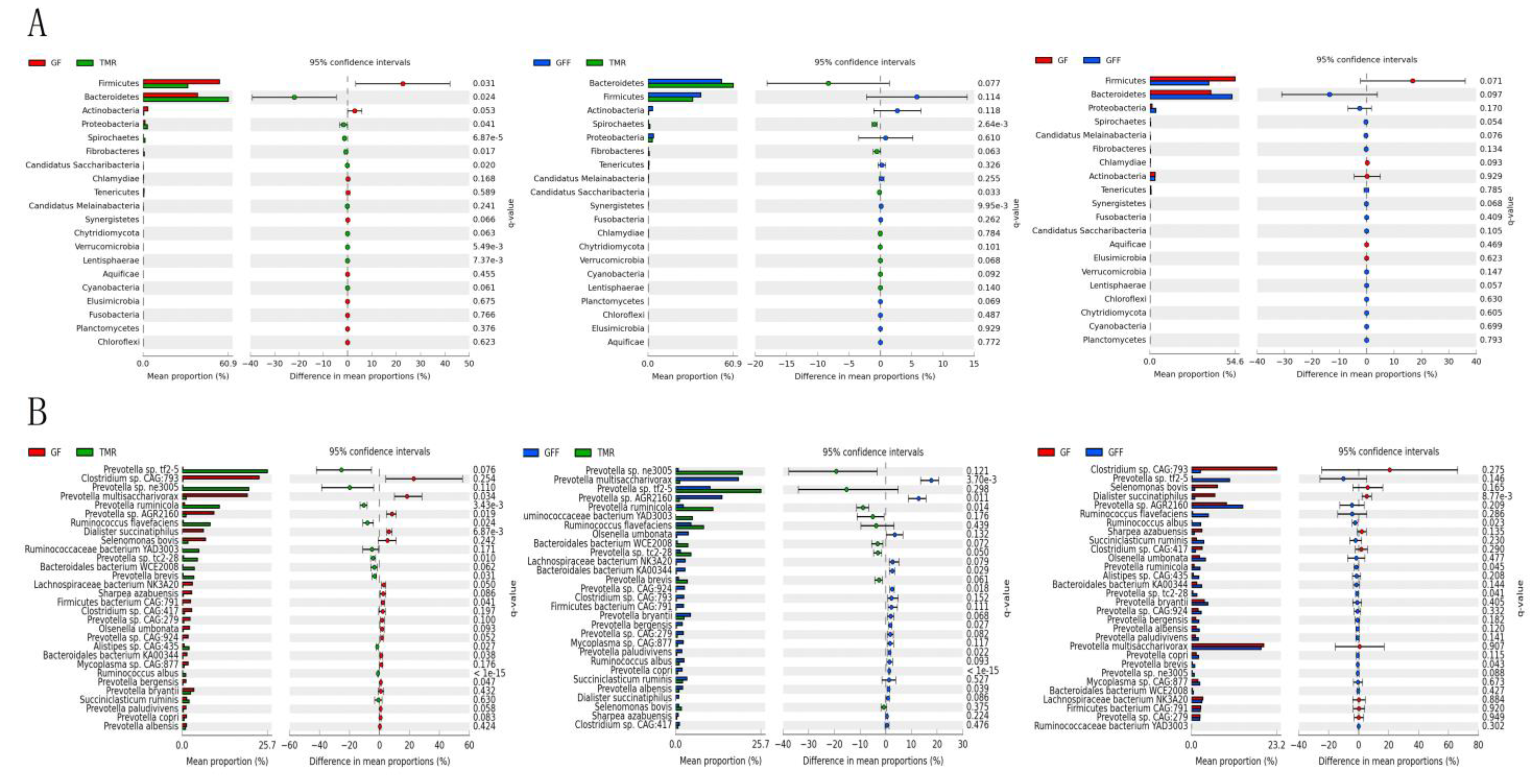

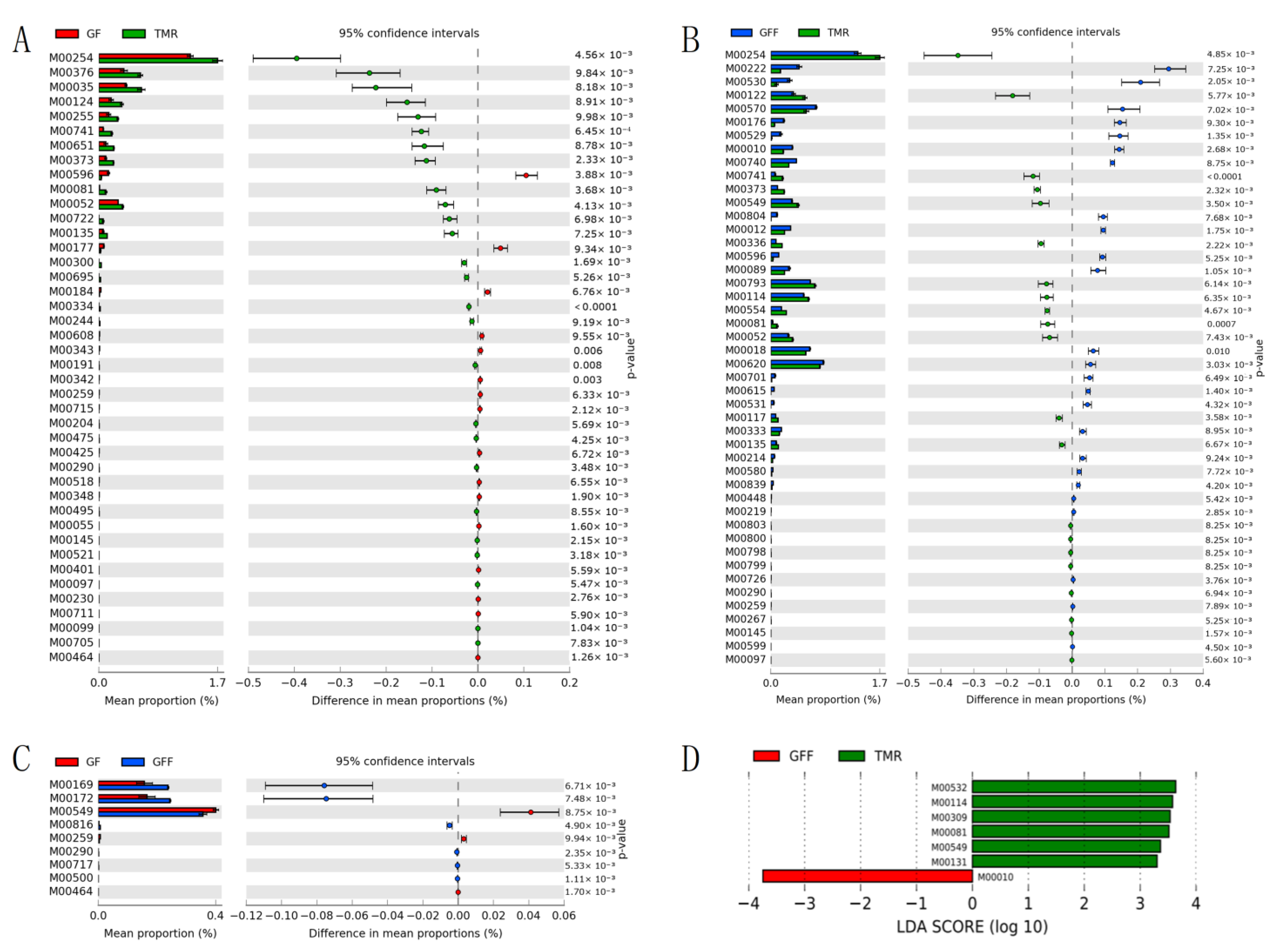
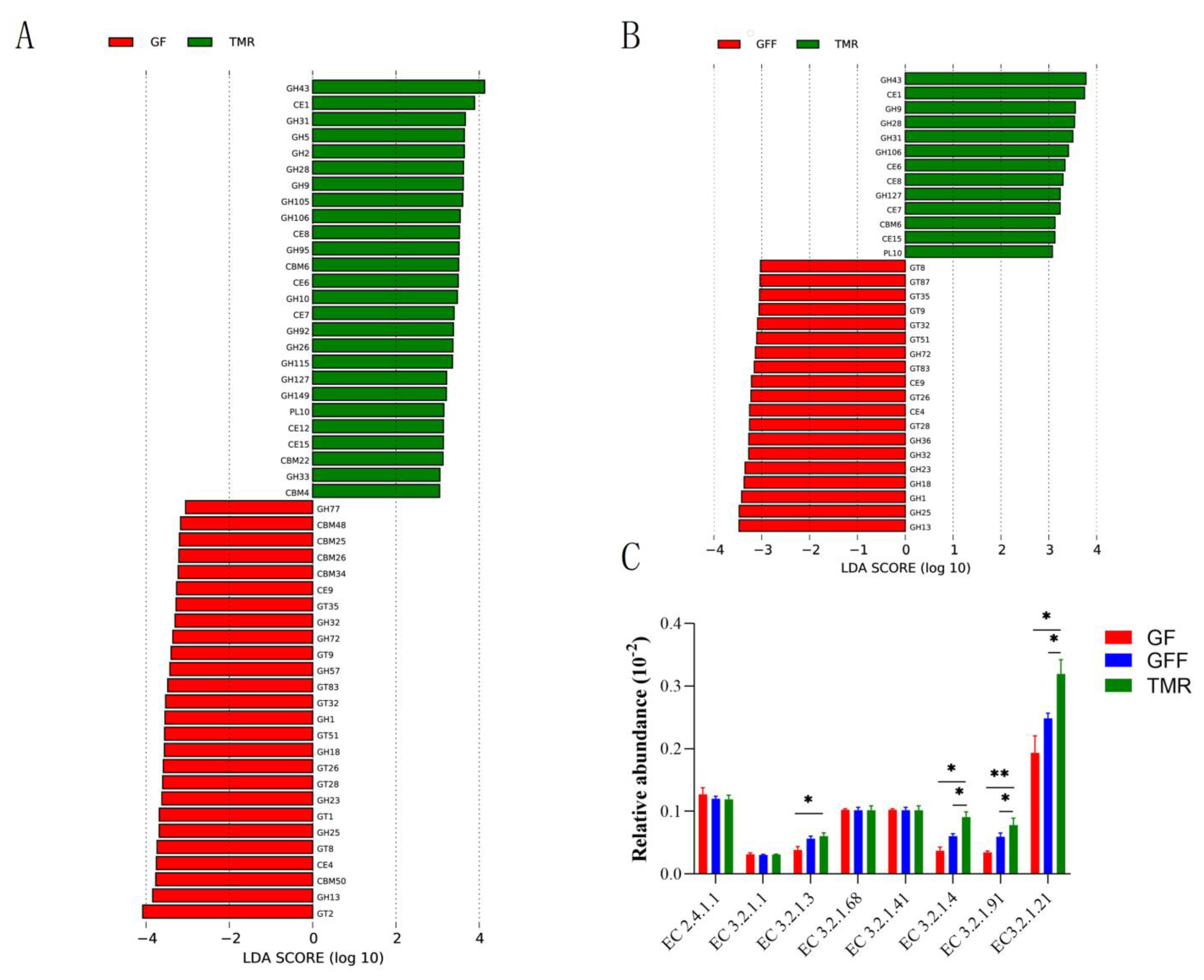

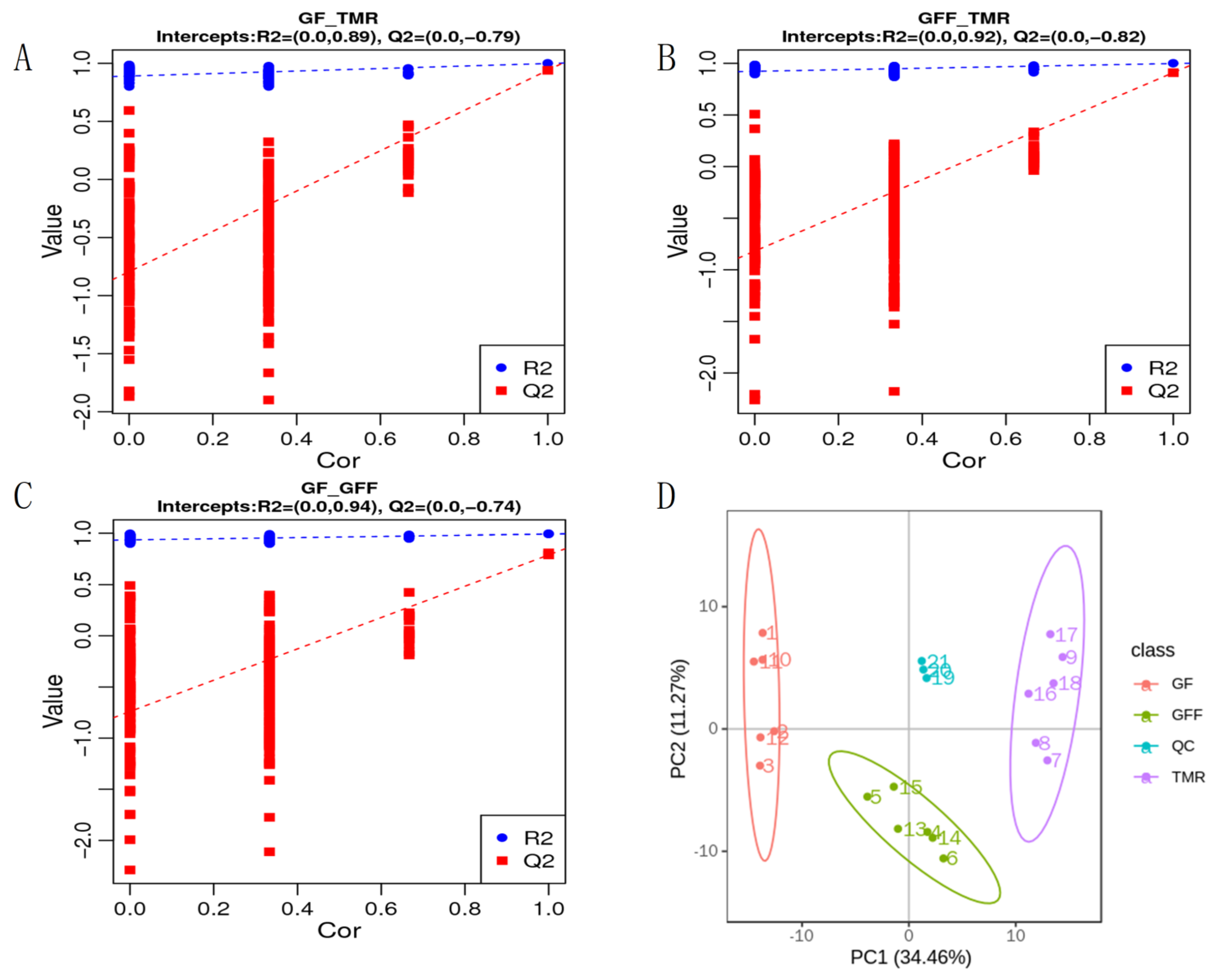
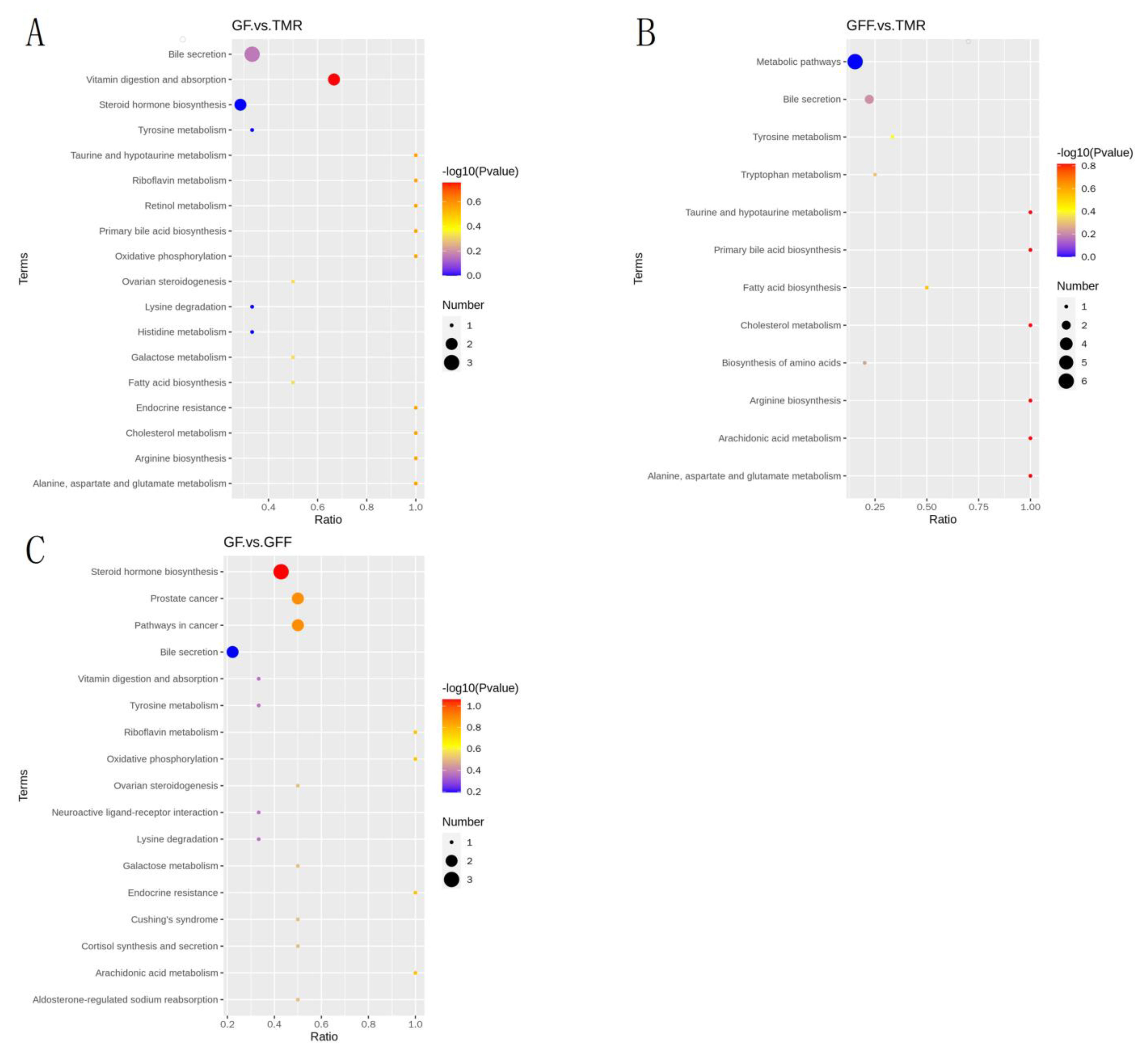
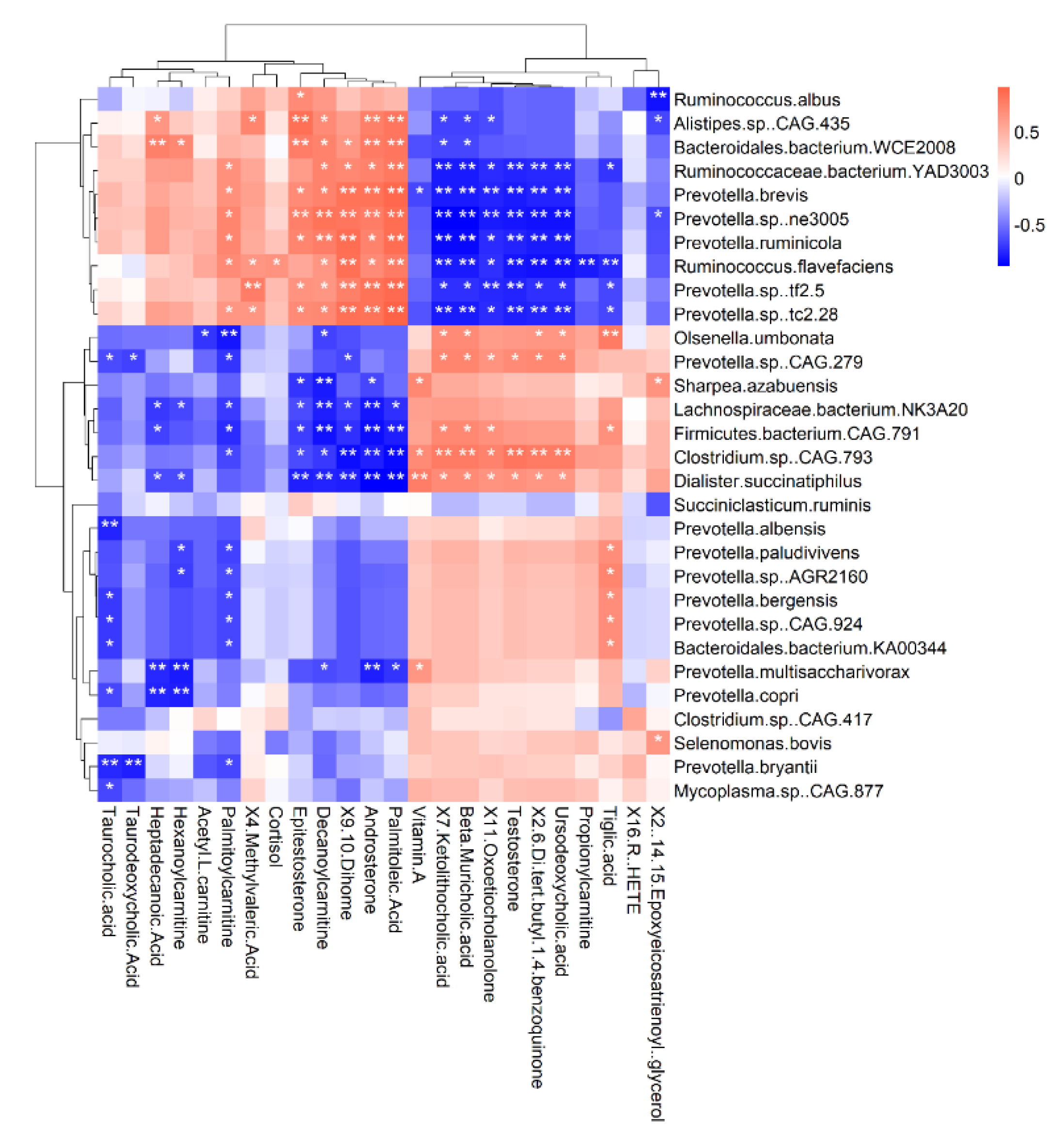
| Parameters | GF | GFF | TMR |
|---|---|---|---|
| birth weight (kg) | 41.38 ± 1.37 | 40.95 ± 1.58 | 42.45 ± 1.63 |
| slaughtering weight (kg) | 100.62 ± 1.94 a | 100.07 ± 1.92 a | 90.77 ± 2.42 b |
| liveweight gain (kg) | 59.23 ± 7.77 | 59.12 ± 8.44 | 48.32 ± 11.82 |
| weight of rumen (kg) | 3.35 ± 0.11 a | 2.35 ± 0.69 b | 2.30 ± 0.0.68 b |
| volume of rumen (L) | 32.62 ± 0.41 a | 20.48 ± 3.22 b | 21.00 ± 6.07 b |
| The ratio of rumen to live weight (%) | 2.14 ± 0.03 ab | 2.35 ± 0.43 a | 1.57 ± 0.17 b |
| The ratio of rumen to total stomach weight (%) | 60.95 ± 2.40 a | 61.13 ± 3.34 a | 52.38 ± 0.59 b |
| the pH of the rumen | 6.63 ± 0.16 a | 5.33 ± 0.26 b | 6.30 ± 0.13 a |
| Sample | Archaea | Bacteria | Eukaryota | Viruses | Others |
|---|---|---|---|---|---|
| GF1 | 545,056 | 35,433,043 | 3710 | 25,237 | 6,172,506 |
| 1.292% | 84.005% | 0.009% | 0.060% | 14.634% | |
| GF2 | 460,365 | 35,799,595 | 2891 | 43,392 | 5,873,309 |
| 1.091% | 84.874% | 0.007% | 0.103% | 13.925% | |
| GF3 | 363,255 | 34,506,676 | 1810 | 172,246 | 7,135,566 |
| 0.861% | 81.809% | 0.004% | 0.408% | 16.917% | |
| GFF1 | 221,641 | 35,363,072 | 2490 | 60,795 | 6,531,555 |
| 0.525% | 83.839% | 0.006% | 0.144% | 15.485% | |
| GFF2 | 998,998 | 34,991,380 | 2715 | 43,146 | 6,143,314 |
| 2.368% | 82.958% | 0.006% | 0.102% | 14.565% | |
| GFF3 | 368,137 | 35,470,400 | 6350 | 55,213 | 6,279,452 |
| 0.873% | 84.094% | 0.015% | 0.131% | 14.887% | |
| TMR1 | 76,604 | 36,590,887 | 5652 | 31,771 | 5,474,639 |
| 0.182% | 86.750% | 0.013% | 0.075% | 12.979% | |
| TMR2 | 158,477 | 36,270,649 | 11121 | 40,252 | 5,699,055 |
| 0.376% | 85.991% | 0.026% | 0.095% | 13.511% | |
| TMR3 | 215,850 | 35,870,047 | 14,373 | 80,548 | 5,998,736 |
| 0.512% | 85.041% | 0.034% | 0.191% | 14.222% | |
| mean | 378,709 | 35,588,416 | 5679 | 61,400 | 6,145,348 |
| 0.898% | 84.374% | 0.013% | 0.146% | 14.569% | |
| SEM | 92,075.71 | 211,140 | 1449.27 | 14,898.98 | 162,144.56 |
| 0.218% | 0.501% | 0.003% | 0.035% | 0.384% |
| Phylum | Relative Abundance (%) | Mean | SEM | ||
|---|---|---|---|---|---|
| GF | GFF | TMR | |||
| Firmicutes | 43.68 | 29.69 | 25.61 | 32.99 | 0.0323 |
| Bacteroidetes | 31.11 | 41.38 | 48.89 | 40.46 | 0.0302 |
| Proteobacteria | 10.70 | 3.08 | 2.44 | 21.96 | 0.0047 |
| Actinobacteria | 2.72 | 2.56 | 0.44 | 19.10 | 0.0053 |
| Chlamydiae | 0.32 | 0.17 | 0.19 | 0.23 | 0.0003 |
| Tenericutes | 0.56 | 0.62 | 0.44 | 0.54 | 0.0008 |
| Euryarchaeota | 1.08 | 1.25 | 0.35 | 0.89 | 0.0022 |
| Spirochaetes | 0.11 | 0.37 | 1.13 | 0.54 | 0.0016 |
| Fibrobacteres | 0.08 | 0.23 | 0.68 | 0.33 | 0.0010 |
| Synergistetes | 0.07 | 0.14 | 0.03 | 0.08 | 0.0002 |
Disclaimer/Publisher’s Note: The statements, opinions and data contained in all publications are solely those of the individual author(s) and contributor(s) and not of MDPI and/or the editor(s). MDPI and/or the editor(s) disclaim responsibility for any injury to people or property resulting from any ideas, methods, instructions or products referred to in the content. |
© 2023 by the authors. Licensee MDPI, Basel, Switzerland. This article is an open access article distributed under the terms and conditions of the Creative Commons Attribution (CC BY) license (https://creativecommons.org/licenses/by/4.0/).
Share and Cite
Wang, J.; Zhao, K.; Li, M.; Fan, H.; Wang, M.; Xia, S.; Chen, Y.; Bai, X.; Liu, Z.; Ni, J.; et al. A Preliminary Study of the Potential Molecular Mechanisms of Individual Growth and Rumen Development in Calves with Different Feeding Patterns. Microorganisms 2023, 11, 2423. https://doi.org/10.3390/microorganisms11102423
Wang J, Zhao K, Li M, Fan H, Wang M, Xia S, Chen Y, Bai X, Liu Z, Ni J, et al. A Preliminary Study of the Potential Molecular Mechanisms of Individual Growth and Rumen Development in Calves with Different Feeding Patterns. Microorganisms. 2023; 11(10):2423. https://doi.org/10.3390/microorganisms11102423
Chicago/Turabian StyleWang, Jie, Kaisen Zhao, Mianying Li, Huimei Fan, Meigui Wang, Siqi Xia, Yang Chen, Xue Bai, Zheliang Liu, Jiale Ni, and et al. 2023. "A Preliminary Study of the Potential Molecular Mechanisms of Individual Growth and Rumen Development in Calves with Different Feeding Patterns" Microorganisms 11, no. 10: 2423. https://doi.org/10.3390/microorganisms11102423
APA StyleWang, J., Zhao, K., Li, M., Fan, H., Wang, M., Xia, S., Chen, Y., Bai, X., Liu, Z., Ni, J., Sun, W., Jia, X., & Lai, S. (2023). A Preliminary Study of the Potential Molecular Mechanisms of Individual Growth and Rumen Development in Calves with Different Feeding Patterns. Microorganisms, 11(10), 2423. https://doi.org/10.3390/microorganisms11102423






